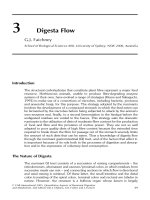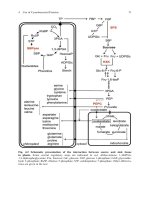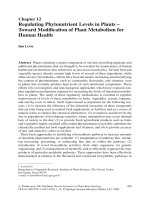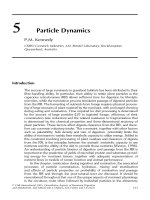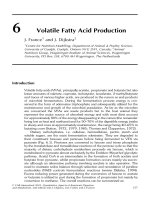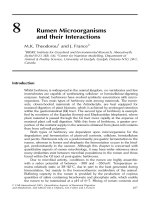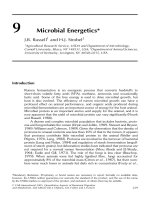Mineral metabolism
Bạn đang xem bản rút gọn của tài liệu. Xem và tải ngay bản đầy đủ của tài liệu tại đây (505.85 KB, 49 trang )
Mineral metabolism
a)
b)
Minerals are classified into:
Principal elements: which exist in the
body in large amounts. e.g. Na, K, Ca,
Mg, P, S, Cl and Fe.
Trace elements: which exist in the body
in small amounts.
e.g. Cu, Co, I2, Mn, F, Mo, Se, Al, Zn and
Cr.
A) Principal elements
1) Calcium
Calcium is present in the body in larger
amounts than any other cation.
The amount of calcium in the body of
adults is about 1400 g.
99% of the body calcium is in the
skeleton (bones and teeth) and the
other 1% is present in other tissues and
body fluids.
A) Principal elements
1) Calcium
Importance of Calcium
Essential for formation of bone and
teeth.
2. Necessary for muscle contraction.
3. It plays an important role in the
transmission of nerve impulses.
4. Activation of certain enzymes.
1.
A) Principal elements
1) Calcium
Absorption of Calcium
1.
2.
About 30% of dietary calcium is absorbed.
Absorption of calcium is affected by the
following factors:
Concentration of calcium in diet: The higher
the concentration, the more the absorption of
calcium.
pH: Calcium salts are soluble in acid
solutions, so, acidity increases the absorption.
A) Principal elements
1) Calcium
Absorption of Calcium
Requirements of the body.
Ca:P ratio: The optimum ratio for absorption
of both elements is about 1:1 or 1:2
Amount of magnesium in diet: Excess
magnesium in diet inhibits calcium
absorption as magnesium competes with
calcium for absorption.
A) Principal elements
1) Calcium
Absorption of Calcium
6.
Amount of proteins in diet: Amino acids form
soluble complexes with calcium, so, high
protein diet favors the absorption of calcium.
Vitamin D: 1,25 dihydroxy vit. D induces the
formation of a carrier protein that is
important for the transfer of calcium across
the intestinal mucosal epithelium.
Parathormone: Involved in the conversion of
Vit. D to 1,25 dihydroxy vit. D, so, it helps
calcium absorption.
A) Principal elements
1) Calcium
Calcium Blood Level
1.
2.
Plasma normally contains 9 – 11 mg / 100 ml
of calcium. 45% of which is non-diffusible )
bound to plasma albumin).
The diffusible calcium (55%) is classified
into:
Ionisable (50%): active form.
Non-ionisable (5%): Calcium citrate.
Erythrocytes almost contain no calcium.
A) Principal elements
1) Calcium
1.
a)
b)
2.
a)
b)
c)
Factors affecting plasma calcium level:
Vitamin D: It increases calcium level as:
It increases absorption of calcium from the
intestine.
It increases reabsorption of calcium by renal
tubules.
Parathyroid hormone (parathormone): It
increases calcium level by increasing:
Absorption of calcium from the intestine.
Reabsorption of calcium by renal tubules.
Mobilization of calcium from bones.
A) Principal elements
1) Calcium
3.
4.
5.
Factors affecting plasma calcium level:
Calcitonin (secreted by the thyroid
gland): It lowers calcium blood level by
inhibiting mobilization of calcium from
bones.
Plasma phosphate: Increase of plasma
phosphates leads to a decrease of plasma
calcium and vice versa.
Plasma proteins: Decrease in plasma
proteins → decrease of the non-diffusible
form of calcium → decrease of total
plasma calcium.
A) Principal elements
1) Calcium
Sources
Cheese and milk (rich sources).
Fruits, vegetables, egg yolk and legumes
(small amounts).
Requirements
For normal adults: 0.8 g/day.
For pregnant and lactating women: 1.2 g/day.
Excretion
1.
2.
In feces: 80%
In urine: 20%
A) Principal elements
2) Phosphorus
Total body phosphorus is about 800 g.
80% in the skeleton and 20% in other
tissues and body fluids.
Phosphorus is present in every cell of the
body.
A) Principal elements
2) Phosphorus
Importance of Phosphorus
1.
2.
3.
4.
5.
Formation of bones and teeth.
Formation of nucleic acids and
nucleotides. e.g. ATP, ADP and cAMP.
Formation of phospholipids,
phosphoproteins, hexose, pentose and
triose phosphates.
Formation of many coenzymes as TPP,
CoA-SH, NAD, NADP, FMN, FAD,
UDP-G and pyridoxal phosphate.
Formation of buffers.
A) Principal elements
2) Phosphorus
Absorption of Phosphorus
Phosphorus is absorbed from the intestine in
the form of phosphates.
Only about 70% of food phosphates are
absorbed.
Factors which help the absorption of calcium
will secondarily help the absorption of
phosphate as unabsorbed calcium inhibits the
absorption of phosphate.
The best Ca/P ratio for the proper absorption
of both calcium and phosphate is 1:1 (1:2 to
2:1).
A) Principal elements
2) Phosphorus
Blood Phosphorus
1.
a)
b)
In plasma:
Inorganic phosphates: 3.5 mg/100 ml.
Organic phosphates: mostly
phospholipids.
A) Principal elements
2) Phosphorus
Factors affecting plasma inorganic
phosphate
I.
II.
III.
Renal function: Renal failure → failure of
excretion in urine → ↑ plasma inorganic
phosphate.
Parathyroid hormone: It inhibits renal
tubular reabsorption of phosphate → ↑
phosphate excretion in urine → ↓ plasma
phosphate.
Vitamin D: Plasma inorganic phosphate
decreases in rickets.
A) Principal elements
2) Phosphorus
Blood Phosphorus
2.
a)
b)
In RBCs:
Inorganic phosphates: Potassium
monohydrogen phosphate K2HPO4 and
potassium dihydrogen phosphate
KH2PO4.
Organic phosphates: mainly in the form
of hexose, pentose, triose phosphates
and ATP.
A) Principal elements
2) Phosphorus
Sources
Cheese, milk, liver, kidney, heart, meats
and fishes.
Requirements
For normal adults: 0.8 – 1 g/day.
For pregnant and lactating women: 1.2
g/day.
Excretion
1.
2.
In urine: 60%
In feces: 40%
A) Principal elements
3) Magnesium
The total body magnesium is about 21 g.
70% in the skeleton and 30% in the other
tissues and body fluids, mostly
intracellular.
Magnesium in muscle cells is about 10
times that in plasma.
A) Principal elements
3) Magnesium
Importance of Magnesium
1.
2.
3.
4.
Magnesium is important for:
Normal contraction of muscles.
Formation of bones and teeth.
Normal transmission of nerve impulses.
Activation of kinases, phosphorylases
and transketolases.
A) Principal elements
3) Magnesium
Absorption of Magnesium
About 40% of the ingested magnesium is
absorbed.
Factors affecting absorption of
magnesium are the same affecting
calcium absorption.
A) Principal elements
3) Magnesium
Blood Magnesium
Plasma magnesium is normally 2.2 mg/
100 ml.
Magnesium in RBCs is about 2 – 3 times
its amount in plasma.
A) Principal elements
3) Magnesium
Factors affecting plasma magnesium
1.
2.
3.
Renal function: Renal failure → ↓
excretion of magnesium →
hypermagnesemia.
Aldosterone → ↑ renal clearance → ↓
plasma magnesium.
Parathyroid hormone → ↑ mobilization
of magnesium from bones → ↑
magnesium in blood.
A) Principal elements
3) Magnesium
Sources
Vegetables (chlorophyll), legumes,
meats, fish, liver, kidney and heart.
Requirement
For normal adults: 0.3 g/day.
Excretion
1.
2.
In feces: 70%
In urine: 30%


